
Port Arthur taken from the ship.
Maureen and I attended a talk about Port Arthur and Hobart. At the end of the Port Arthur talk the speaker stated that we would be anchored off shore, because Port Arthur was not a port that could cope with a vessel of our size. In fact, all they could cope with would be small motor boats.
She also mentioned that it would be a 45-minute boat ride from the ship to the shore. At that distance, which I estimated to be about eight to ten miles off shore, I told Maureen that I didn’t think that we would bother going ashore because it could be quite rough for a tender craft (ship’s lifeboats), and as she hated small boats it would not be a particularly pleasant ride.
That evening in the ship’s newsletter the distance (in time) was confirmed and we made plans to remain on the ship.
I was awake early the following morning and I felt the movement of the ship change and looked out of our window. We’d entered sheltered area. I could see land on both sides of the ship so that we were protected from the ocean. As I looked out I could see Port Arthur.
The distance from the shore was nowhere near a forty five minute boat ride, more like fifteen minutes and in fact I timed it and it was twelve minutes from where the Golden Princess anchored.

At once our plans changed, and we dressed for going ashore.
It was a smooth ride in one of the ship’s tenders to the small pier where we stepped ashore.

Just a short walk to the ruins of Port Arthur.
Port Arthur was a prison that was created in 1830 to supply timber for various government projects using convict labour.
In 1833 it changed to become a repeat offenders prison for criminals from all over Australia. The prison was modelled on the Pentonville prison in the UK, which was described as a ‘machine for grinding rogues in to honest men.’
Some of the prisoners left Port Arthur with the skills of a trade, blacksmith, carpenters and shipbuilders. Unfortunately others became broken men.
Around the prison was a community of military and free men with their families, who lived normal lives of parties, sailing for fun and literary evenings. Gardens were created, and children went to school within the settlement.
Port Arthur grew to be an industrial settlement, and by 1840 more than 2000 people, who were a mix of convicts, soldiers and free men lived, and worked. They produced bricks, furniture, clothing, boats and ships.
Transportation from the UK to Tasmania ceased in 1853 and the prison became an institution for the aged, mentally& physically ill convicts, and finally closed in 1877.
Many of the bricks from various buildings were sold off very cheaply to locals who used them to build or expand their own homes. The name of Port Arthur was changed to Carnarvon to erase the hated convict links.
Over the years convict stories drew tourists to the area, and by the early 1920’s some of the remaining buildings had become museums.
 The prison was a building of four levels – ground floor and first floor for ‘prisoners of bad character’, with individual cells for each prisoner. The top floor accommodated 480 better behaved prisoners and the third floor was used as a dining area, recreational area, and school for the prisoners.
The prison was a building of four levels – ground floor and first floor for ‘prisoners of bad character’, with individual cells for each prisoner. The top floor accommodated 480 better behaved prisoners and the third floor was used as a dining area, recreational area, and school for the prisoners.
The prisoners were told that if they behaved they would be rewarded, and moved from the bottom single cells (see single cell photos), to the floor above, still single cells, and so on, until they reached the top floor. If they maintained their reputation as ‘good’ prisoners, they would be allowed the use of the recreational floor.
The picture above, and the one below, is of single cells on the ground floor.
 A plaque can be seen in the above photograph, which I have reproduced below.
A plaque can be seen in the above photograph, which I have reproduced below.


Many Australian consider it a badge of honour to have a transported criminal in their family background. Often people will tell you, with pride, that their forefathers were transported for stealing just a loaf of bread or some other small item, but many where habitual criminals and the stealing of the loaf was the last straw for the magistrate. Many were sentenced to seven years and could have returned to the UK after serving their time, but chose to stay in Australia because they had been given ‘tickets of leave’ for good behaviour during their time as a prisoner, and had created a new life in Australia, and eventually became a free man or woman.
I researched my own family tree and found George Woodland, who was convicted in 1790 at the Old Bailey in London, for stealing a coat. He was sentenced to be transported because he had a string of offences. After spending two years on a prison hulk he sailed from Gravesend (which is on the south bank of the Thames) in 1792 as one of 300 males prisoners in Royal Admiral. The ship finally sailed from Torbay, which is on the southern coast of the England, on the 30th May 1792, and arrived in Sydney on the 02nd October of the same year. I found a picture of the Royal Admiral on the internet.
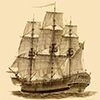 George Woodland is listed on the ship’s manifest as John Woodland, but all other information points to George and John being the same person. (Court records etc).
George Woodland is listed on the ship’s manifest as John Woodland, but all other information points to George and John being the same person. (Court records etc).
One of the seamen on the ship was also named Woodland (coincidence?), but his Christian name was James.
Maybe the clerk who made out the manifest wrote ‘John’ instead of ‘George’, perhaps being influenced by his shipmate’s name i.e James.
The Royal Admiral was 914 gt, 120 feet (36 mtrs) in length, by 38 feet (11.5 mtrs) beam and had about 481 people onboard, which included several children, 49 female convicts, 20 soldiers, a number of free people, about 50 crew and 300 male prisoners.
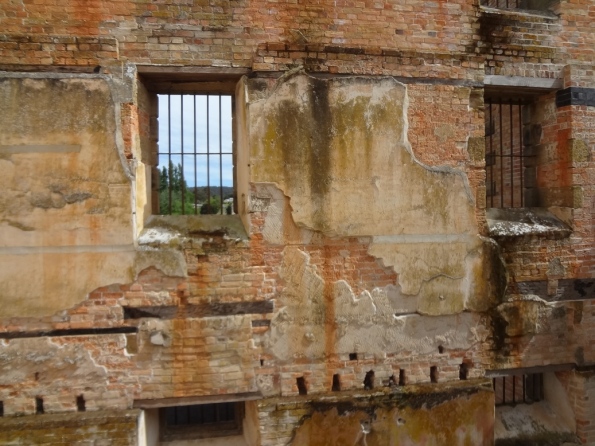 First floor of the prison.
First floor of the prison.
 Second floor – the metal supports that can be seen are to help keep the walls from collapsing during earthquakes.
Second floor – the metal supports that can be seen are to help keep the walls from collapsing during earthquakes.
 Guard Tower – across the road from the prison.
Guard Tower – across the road from the prison.

Many old buildings are missing, but this shows the view down to the water.
The prison is on the left of the picture and the Guard Tower on the right-side of the picture.
 A model of the early ‘town’. If it was real I would be standing at the prison looking inland to the town. The building on the bottom right is the Law Courts, the building on the left with the path is the Commandants House, the area in the middle is the Guard Tower and behind that are the officer’s accommodation.
A model of the early ‘town’. If it was real I would be standing at the prison looking inland to the town. The building on the bottom right is the Law Courts, the building on the left with the path is the Commandants House, the area in the middle is the Guard Tower and behind that are the officer’s accommodation.
 Outside of the Commandant’s home today.
Outside of the Commandant’s home today.
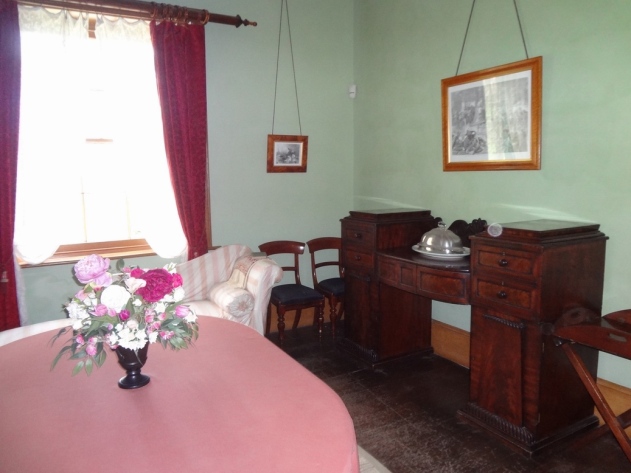 Commandant’s dining room
Commandant’s dining room
 Views of his study
Views of his study

 Kitchen
Kitchen
 I had to take a picture of the recipe.
I had to take a picture of the recipe.
On each of the Princess cruises that Maureen & I have sailed, the ship always has bread and butter pudding on the menu, which I have found to be very good. I have my grandmother’s hand written note book in which she wrote details of various recipes, and one is Bread and Butter pudding, so I must compare the two – the one above and my grandmother’s written in 1896.

A single bedroom in the Commandant’s house.

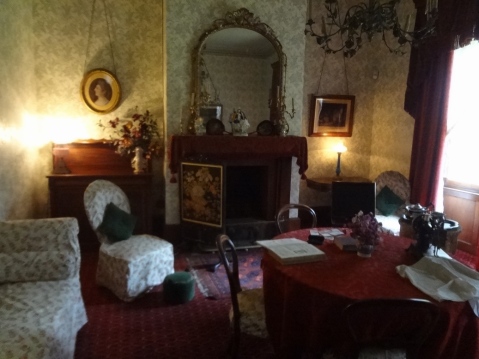 Sitting room
Sitting room
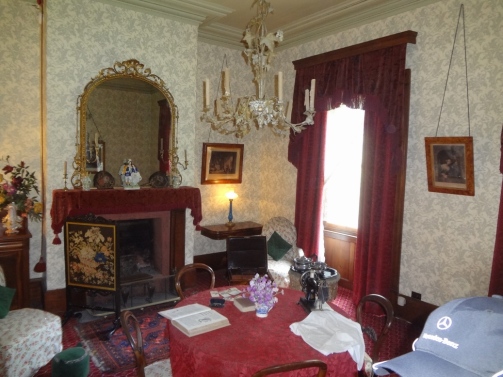
All of the above is history, but below is the sad fact of today’s world.
On the 28th April in 1996, a gunman opened fire on tourists and staff and murdered thirty-five people, wounding a further twenty-three.

At the Broad Arrow Café in Port Arthur, where the killings took place there is now a pool of remembrance, and a place of peace and reflection. The café is no longer there.
 Death has taken its toll, some pain knows no release, but the knowledge of brave compassion shines like a pool of peace.
Death has taken its toll, some pain knows no release, but the knowledge of brave compassion shines like a pool of peace.
 Each leaf (ceramic leaves I think) in the water represents a murdered victim.
Each leaf (ceramic leaves I think) in the water represents a murdered victim.
There was such an outrage that within three months the Australian Federal Government and all Australian States changed the law as to the type guns allowed to be owned by citizens. The Federal Government bought back 640,000 guns and had them melted down. With the political will, and courage, gun control is possible.
The killer was sentenced to 35 life sentences without the opportunity of parole, plus 25 years for the remaining 36 charges on 5 other offences (20 attempted murders, 3 counts infliction of grievous bodily harm, the infliction of wounds upon a further 8 persons, 4 counts of aggravated assault and 1 count of unlawfully setting fire to property.

Twenty years after the event, the pool with the floral tributes near what was the Broad Arrow Café. For more information read this link.
From the memorial we returned to the ship deep in thought. As we left the shore and started the steady chug back across the water I noticed a RAN (Royal Australian Navy) vessel had arrived.


The final tender boat arrives as we prepare to sail.

The gap in the land through which we will sail to the open sea.

Interesting post especially about the family lineage. As an aside, I wish the United States would institute the kind of common sense gun laws that Australia has, though I am not optimistic.
LikeLiked by 2 people
Thank you for this amazing excursion. Port Arthur is one of the places I would love to visit some day.
LikeLiked by 2 people